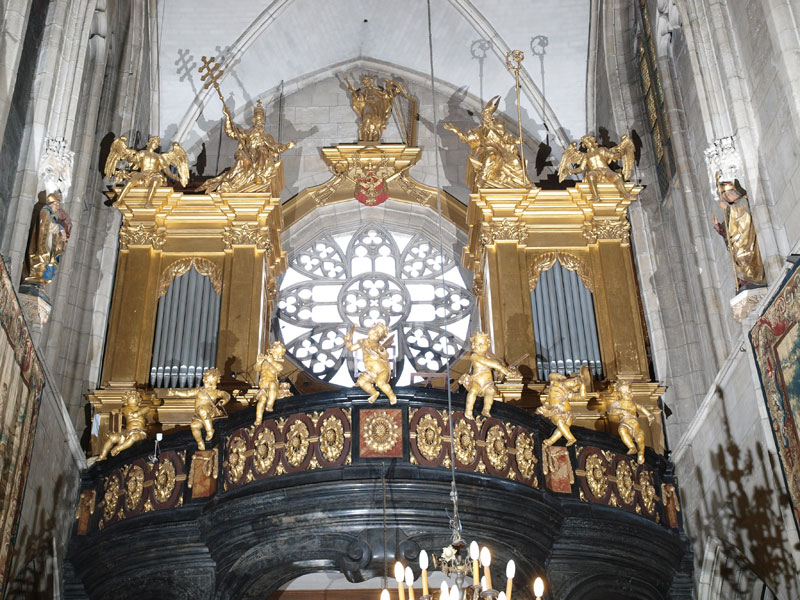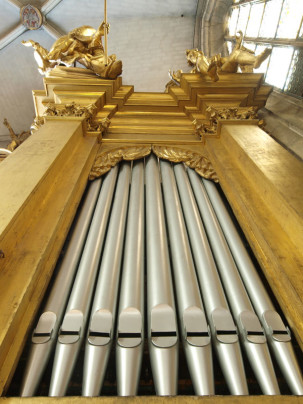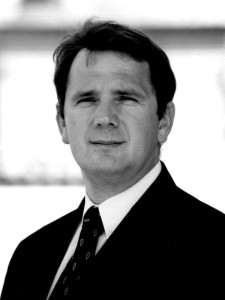Literature concerning the history of Cracow Cathedral contains unconfirmed accounts about the organ which was believed to be in the church as early as AD 966. A more reliable account about such an instrument at the court of Kazimierz (Casimir) the Just (1138-1194) originates from Rev. Wincenty Kadłubek’s chronicle.
In the years 1502-1506, the organmaster Stanisław Komorowski built ”the grand organ” for the Cathedral, most probably situated in the main nave. It is believed that in 1511 another organ was executed by Mikołaj de Scharby, presumably much smaller and situated in the chancel. It should also be added that The Ponitifical of Erazm Ciołek of around 1505, in its page titled ”The King in His Majesty”, contains an illustration of the interior of Wawel Cathedral’s chancel. On the right of this graphic work the organ front is depicted, believed to be the work of Mikołaj de Scharby. Its flat organ front is installed on a pedestal and contains a small number of front pipes. Its top is in the form of a late-Gothic ornament. The organ case is flanked by movable, hinged wings, adorned with painting decorations. The organs with such wings were usually closed and opened only when played. Further history of this organ remains unknown.
- Organ loft
The above-mentioned the “grand organ” of Stanisław Komorowski, dating from the years 1502-1506, was repaired in 1604 by organmaster Malcher, identified with a high degree of probability as Melchior Kuchta. Major reconstruction of the organ was conducted in the years 1720-1727, under organmasters Szymon and Krzemycki. In the years 1756-1758, a new late-Baroque organ-loft was built in the Cathedral.
In 1785 the renowned organmaster who was active in Cracow, Ignacy Ziarnicki (vel Ziernicki), built the new organ for the Cathedral, installed on the organ-loft in the main nave. Finishing work on its organ front, which has survived to this day, continued for a longer time, as its construction dates to the years 1785-1788. Chronicler accounts say that Cathedral organists were generally renowned, outstanding musicians. This is confirmed, for example, by Kurpiński’s account of 1819 which goes as follows: “…Varsovians would envy Cracovians their skilful organists…”.
In 1912 the following announcement could be read in Cracow periodical for organists, Muzyka i śpiew: ”…A Great Convention of Organists Delegates was held in Cracow”. On that occasion they had the opportunity to visit “… the organ factory of K[azimierz] Żebrowski and to watch its staff at work on the Wawel organ…”. Considering the above, it can be assumed that general reconstruction of that instrument was carried out at that time, resulting in the installation of the electrical and pneumatic console which is still in operation. Major changes in the sequence of organ stops was also made. The organ has survived to the present times unaffected.
The organ has been installed by the western wall of the Cathedral. The late-Baroque organ-loft, in-laid in black Dębnik marble, dates from the years 1756-1758. It was designed by outstanding architect Francesco Placidi. The Baroque-classicist organ front from the years 1785-1788 is architectural and consists of two parts flanking the central octagonal rosette on the Cathedral axis. Both organ cases, gilt all over, are composed following the same design, in the form of semi-circular central arcades, both flanked with pillars with Corinthian capitals, supporting the profiled entablature. The rosette is also framed and thus compositionally consistent with the organ structure. Rich figurative sculpture adds to the organ decor. Music-making putti adorn the baluster of the organ-loft, while the organ front is surmounted by larger-size figures: centrally (over entablature framing the rosette) is King David playing the harp; on the inside parts of the organ cases are St Damasius (the Pope) and Marcin Szyszkowski (Bishop of Cracow, the founder of the Cathedral vocal and instrumental ensemble which was created in 1619); on the outer sides of the organ cases are the figures of angles playing the music.
Bibliography:
Czyżewski Krzysztof J., Królewska Katedra na Wawelu – przewodnik, Wydawnictwo św. Stanisława BM Archidiecezji Krakowskiej, Cracow 2002;
Gołos Jerzy, Polskie organy i muzyka organowa, Instytut Wydawniczy PAX, 1972;
Łyjak Wiktor Zygmunt, Organy na Mazowszu w diecezji płockiej od XIV wieku do 1818 roku, Towarzystwo Naukowe Płockie, Płock 2005;
Petrus Jerzy T., Wawel – Zamek i Katedra – Mini-przewodnik, Wydawnictwo Tessa [place and year of publication unknown];
Rożek Michał, Krakowska Katedra na Wawelu – przewodnik dla zwiedzających, Wydawnictwo Kurii Metropolitalnej, Cracow 1986.
Compiled by: Piotr Matoga
ORGAN STOPLIST:
Manuał I
Bourdon 16′
Principal 8′
Major flute 8′
Gemshorn 8′
Portunal 8′
Gamba 8′
Oktave 4′
Minor flute 4′
Horn 4′
Quinte 2 2/3
Piccolo 2′
Mixture 2-4x
Trumpet 8′
II/I
Super II/I
Subo II/I
Manuał II
Flute 8′
Amabilis 8′
Quintadena 8′
Salicet 8′
Vox Celestis 8′
Principal 4′
Traverse flute 4′
Violin 4′
Night horn 2′
Tertia 1 3/5
Sifflet 1′
Cymbal
Clarinet 8′
Tremolo II Pedal
Contra-Violone 16′
Subbas 16′
Oktavbas 8′
Celo 8′
Choralbass 4′
Trombone 16′
I/P
II/P
Organists
Walenty Dec
Organist at St Anne’s Church, and later at the cathedral, and conductor of the cathedral choir at Wawel. In the years 1895-1928 he taught the organ, and in the years 1889-1928 he was also a teacher of the theory of music at the Conservatory of the Musical Society in Cracow. He was a great promoter of the revival of church music in Cracow in the spirit of the reform initiated by Pope Pius X. He wrote music for Latin Mass and Christmas carols for the Men’s Choir. He died in 1938.
Michał Jan Woźny
Born in Spytkowice near Wadowice in 1902, he was the most renowned personage among church musicians, and in particular those associated with the central place – Wawel Cathedral. He took his first singing and piano lessons from his father who was an organist at a parish church, and then continued his education in the organ class at the Conservatory of the Musical Society, where he met Father Bernardino Rizzi – a professor of the theory of music, harmony and counterpoint. In 1924 Woźny obtained his Diploma at the Conservatory of the Musical Society. Initially he worked as an organist at the Missionaries’ Church in Cracow, then he won a competition for the position of organist at St Elizabeth’s Church in Lvov. In 1926, having passed a state exam qualifying as a teacher of music, singing and piano, he was employed as a music teacher at the Stanisław Moniuszko Musical Schools for the Blind at the Institution for Care of the Blind in Lvov. Michał Woźny conducted choirs and gave organ concerts in Lvov. In 1945 he won a competition for the post of organist at Wawel Cathedral where he created the Men’s Choir which gave concerts every Sunday after High Mass. He also worked as a pedagogue at musical schools and published popular classical music pieces. As a choir master he wrote many vocal and organ pieces for ensembles in Lvov and Cracow. He also adapted songs, Mass music and religious compositions for the organ. In 1976 Pope Paul VI awarded him the order Pro Eccelesia et Pontifice, Michał Woźny died in Cracow on 18 January 1990. Three years later, on 10 January 1993, a commemorative plaque in honour of Michał Woźny’s activity was placed and consecrated at Wawel Cathedral. His musical output contains vocal compositions on religious themes (46) and on secular themes (20), adaptations of vocal religious compositions (202) and of secular compositions (13), as well as compilations of instrumental pieces (5). He is still well remembered by the members of the cathedral choir.
Witold Zalewski
He began his education in playing the organ at the State Musical School in Cracow under Mieczysław Tuleja, graduating in 1992 from the Musical Academy in Cracow at Professor Jan Jargoń’s organ class. He perfected his art during organ music interpretation courses under J. Laukvik, G. Schneider and J. Guillou. Since 1995 Witold Zalewski has been an organist at Wawel Cathedral. As a soloist he has given concerts in Poland and abroad (in the Czech Republic, Germany, Hungary, Finland, Russia, Switzerland, Ukraine, the USA and other countries). In April 2007 he performed at St Patrick’s Cathedral in Manhattan, New York, during a concert held to commemorate the second anniversary of John Paul II’s departure to the House of the Father. Since 1998 Zalewski has been a member of the Church Music Committee at the Metropolitan Curia in Cracow. During papal pilgrimages of the Holy Fathers John Paul II and Benedict XVI, Zalewski was the organist during liturgical services held at Wawel Cathedral, the Sanctuary in Łagiewniki, and on the Cracow Błonia. Witold Zalewski is the author of a church songbook published by the Polish Musical Publishing House in 1997 as well as a co-editor and co-author of many other publications (e.g. The Wawel Songbook). He is also the director of the International Organ Music Festival in Zakopane and co-organiser of concerts in Southern Poland.
- Witold Zalewski



